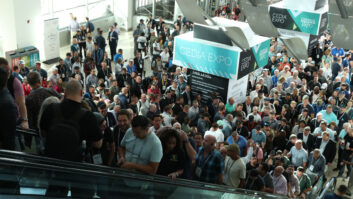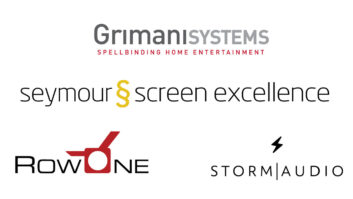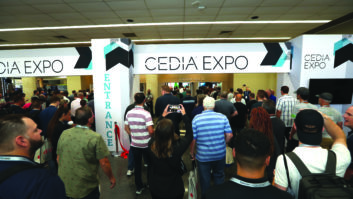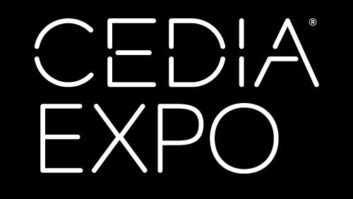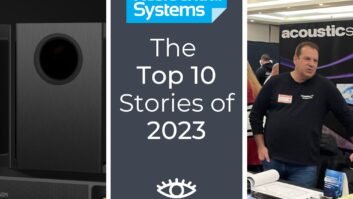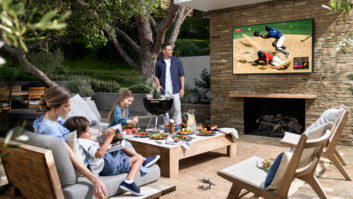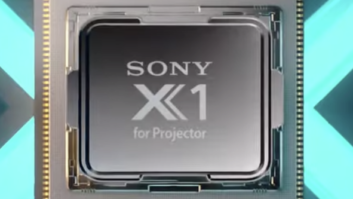I’ve never been a numbers guy, and the focus at every trade show I’ve ever attended on attendance numbers has always annoyed me. While I respect the need by exhibitors to tie their return on investment in a show to show traffic, my focus is on the quality of products and technology on display, rather than how many people I have to squeeze by to get to my meetings and press conferences. So when it came to judging CEDIA EXPO on numbers alone, the show could have been a disappoint to some. From a quality of information and products, however, I thought EXPO was as good as ever. Here are just a handful of observations that I made last week, along with insight from my colleagues Lindsey Adler and Derek Dellinger. Many thanks to John Sciacca, who was also a huge help covering the show for us. Our October and November issues of Residential Systems will feature more on these companies and many others.

Jeremy Glowacki:
I won’t be the first or last to note the EXPO buzz about 4K projection. Both Sony and JVC offered their versions of this next-generation technology for the home, and it was refreshing to hear about a video technology other than 3D for a change. Sony might have the upper hand here because it owns the content pipeline from the camera through production, post-production, and into the digital cinema and home. Also, Sony’s dedication to the high-end custom installation is admirable. It’s VPL-VW1000ES is its first consumer 4K digital projector, and the company stressed that it is not a rebadged version of one of its digital cinema lines. The big selling point for 4K, when content is more readily available, is that it will allow viewers to sit much closer to the action on the biggest home theater screens with images that deliver considerably more detail and fewer artifacts.

JVC’s Gary Klasmeier, product engineering manager, D-ILA Systems.Both Sony and JVC unveiled more than 4K, with JVC introducing eight new front-projection models, all of the 3D-capable. For 2012, the manufacturer will introduce four models that display 2D HD content with “full 4K precision.” The new models, which start at pricing under $8,000, feature a new technology called e-Shift that can display images with 3840 x 2160 resolution from a native 2K chip. The Reference Series includes the DLARS65, DLA-RS55, DLA-RS4800, and DLARS45. From the ground up, all projectors are 3D-enabled, feature a 2D to 3D converter, and have a new parallax adjustment allowing the user to tailor the effect of the 3D image. Additionally, the projectors all feature a new lens memory function that stores custom focus, zoom, and horizontal and vertical lens shift positions, allowing installers to set up a constant-height 4:3, 16:9, and 2:35 screen without needing to use an anamorphic lens system. Further, all models feature a LAN connection for system control and firmware and screen mode updates.
Not to be outdone, Digital Projection, SIM2, and Runco also showcased an impressive array of new front projection technologies. DPI’s booth was full of stunning images, but its coolest projector was the dVision Scope 1080p, a native 2:35:1 precision DLP projector delivering over 2.75 million pixels of imagery when scope HD content is displayed. What’s most notable is that it delivers a true 1080p solution for 2:35 aspect content without optical stretching and without the need for an anamorphic lens solution.
SIM2 rounded out its largest product launch (15 models) by showcasing its new Nero 3D-2 single-chip 3D projector while emphasizing its dedication to the luxury market. Using the same technology as the company’s Lumis 3D in the single-chip price and performance category, the Nero 3D-2 uses active 3D technology and produces 2,000 ANSI lumens.
One year after launching its 3D Constant Stereoscopic Video (CSV) technology, Runco launched the D-113d, the latest addition to its 3Dimension series. This new model features the most brightness and allows for the largest screen sizes of any Runco projector ever. The D-113d is capable of blasting out 11,570 lumens and driving screens up to 420-inches wide, making it the perfect solution for very large, private home cinemas. In its demonstration, the system produced 100-foot lamberts on a 215-inch wide screen.
In an announcement that maybe the biggest product category “gamechanger,” Lutron introduced its Sivoia QS battery-powered cellular shades at a significant price reduction from previous automated shades products. The shades use a hybrid-drive design and efficient standby power dubbed Triathlon Battery Life Technology to extend standard D batteries to three years. Three versions are available: a nonsystem version, controlled by an infrared remote, priced at $299; a non-system version controlled by Lutron’s Pico wireless remote control, priced at $324; and the Sivoia QS system version, which is compatible with HomeWorks QS, RadioRA 2, and GRAFIK Eye QS, for a base price of $424. The attractive price point is the most significant component of this product introduction, and it showcases Lutron’s commitment to a broader consumer base.

David Weinstein, Lutron VP of residential sales, discusses the significant price reduction on the company’s Sivoia QS battery powered cellular shades.
Another burgeoning trend involved much more reliable wireless audio options becoming available from Proficient and NuVo, following on the heels of what was already available from companies like Sonos and Soundcast Systems (see below). Proficient, the sister company of SpeakerCraft that focuses its attention on the upcoming security channel integrator, introduced its Proficient Zero wireless music system, which consists of a transmitter and amplified receiver for transmitting stereo sound up to 90 feet. Built with the retrofit movement in mind, the Zero system can expand up to eight receivers per transmitter, which has three analog audio channel inputs and an optical audio one. Proficient has also introduced its Music in Minutes kit, aimed to help dealers demo and sell the Zero wireless system. The kit includes the Zero system plus a pair of Proficient AW400 speakers and connecting cables all in an aluminum flight case. The kit will be available to dealers free after purchasing three ZERO systems.
While Proficient made a big splash with a press conference and full-spread magazine ads and show banners, NuVo did a soft launch at CEDIA EXPO, calling its new wireless audio line “a preview.” The company showcased two amplified zone players that use Wi-Fi to stream internet radio services and music stored on networked PCs and network-attached storage (NAS) drives. Songs stored on PCs and NAS drives will be directed to multiple zones players throughout the house from a Wi-Fi handheld touchscreen remote or from Android and Apple tablets and smartphones loaded with a NuVo app. Multiple songs can be streamed simultaneously.
Even Monster, the king of wire, acknowledged the move toward wireless with the launch of its Monster Streamcast BT Bluetooth streaming connectivity that goes hand in hand with its new Clarity HD self-powered speakers. With it, Monster has an exclusive on AAC streaming to deliver the highest quality audio over Bluetooth.
On the wireless video side of the fence, Peerless-AV offered its Outdoor Wireless Mounting Kit, which combines the latest mounting technology with advanced high-definition wireless signal transfer technology. Installers now have the freedom to mount outdoor TVs without cabling limitations and stream 1080p content up to 131 feet through walls and floors with no delays and without having to run signal cable from a source device.
And before moving away from the topic of wireless, Dana Innovations, parent company of Sonance and TRUFIG, introduced LaunchPort, from its iPort brand. This truly innovative inductive charging and mounting system for iPad 2 features a PowerShuttle hard case, a BaseStation table-top mounting and charging location for the PowerShuttle, and a WallStation wall mounting and charging location for the PowerShuttle. In a nutshell, you can now stick your iPad to the wall and charge it without plugging into an AC outlet.
Also in the interesting iPad mount category was an Austrian company called iRoom, which is just beginning to sell its innovative, in-wall, iDock product in the United States. The iDock is a motorized docking and release station, so with the push of a button, the docking station extends out, users slide an iPad in, and the station returns to its flat position in the wall. You can watch the iDock in action here.
As for big ecosystem control products, Crestron emphasized the reality of the analog sunset, promoting its trade-in program for customers transitioning from analog to digital. The manufacturer showcased its open architecture mobile apps supported by its Core3 user interface. A featured attraction in the company launch booth was a technology tunnel showing Crestron’s scalability from single-room control to full-scale capabilities. “With Crestron, you’re never going to max out the system. There is no deadend,” Crestron’s Jeff Singer said.
After introducing its 2.0 operating system last year, Control4 launched 2.1 this year. It features Detective Suite and its Programming and Bindings tools that help “sniff out” all of the IP addressable devices in the house to make sure everything is functioning correctly without latency, and confirms that the Zigbee mesh network is performing properly. OS2 is remotely accessible from the cloud, and allows for greater third-party integration through a Flash-based software development kit and enables the creation of various applications for control, security, and entertainment.
Besides its loudspeaker line partnership with Bay Audio and shipping version of its iPhone touch-embedded handheld remote control, the most interesting development from Savant was its SmartEnergy Monitor model SEM-1024. This product measures energy usage and production in a real time and can also deliver historical usage data from multiple energy management devices. It connects to the main electrical panel via clip-on current transformers, and then sends collected data to a Savant SmartSystem using the LAN. In the future, the company hopes to enable consumers to establish specific usage targets and see tangible results from the changes they’ve made.
ELAN continued to pick up momentum with its g! platform at CEDIA EXPO. Designed for what ELAN’s Robert Ridenour called “normal person control,” g! can control nine subsystems from pre-built GUIs (that can be customized if needed). ELAN maintains that most clients don’t require customized interfaces for their control devices, and actually prefer a consistent look and feel. The company also makes sure that the primary entertainment room controller is a wand-style remote, to keep things simpler for the end user. Perhaps the coolest feature of all for the integrator, however, is a “discover devices” button designed to save hours of programming.
While continuing on a path beyond its remote control past and toward whole-house control systems with the introduction of its first AV receiver (the 9.2-channel TSP-2000 with streaming capabilities built in), URC also introduced several new wand-style remotes, including the splashproof MXW-920, which features a monochrome LCD that displays text. Its water resistance rating is JIS Class 4, IP-class 54, which means that splashing water from any direction will have no effect on the MX-920. Programmed just like URC’s well-regarded MX-900 and KP-900 devices, the MXW-920’s one-way RF design is similar to that of the MX-900, but with improved transport functionality. Four AAA-size alkaline batteries power the MXW-920.
Meanwhile RTI introduced its XP Series processors, which are smaller and more affordable than their predecessors. XP8 provides two-way control, iPad integration (Android by the end of the year) and Surfir remote for the company’s Virtual Panel technology. Surfir mimics what the iPad is doing, so the remotes never get out of sync with each other within a system.
A new company called Clare Controls introduced its ClareHome system, a home automation system managed from the cloud and run from a Mac mini. The solution enables end users to control their homes through Apple iPads, iPhones, and web browsers, as well as to modify their own user experience with the systems after it has been configured and deployed by an integrator. By accessing the cloud-based Applet library, the user may customer their interface instantly without the help of a professional programmer or technician.

Clare Controls president and owner Brett Price demonstrates the company’s cloud-based home automation solution.
NavNet is also new to the U.S. market, and demonstrated its home automation solution. NavNet offers a no-programming approach with a web-based installer interface, giving dealers the option to have a fixed cost installation and simple web maintenance. According to the company, dealers need only to enable features such as internet radio, SiriusXM, and Netflix, which are built in to NavNet’s controller for instant functionality. Integration with third-party lighting systems is accomplished by selecting supported lighting models from a drop-down list. NavNet then pulls all information together and generates the GUIs. Security, HVAC, multiroom audio, and more are accomplished in a similar way.
Moving back to audio, Harman debuted QuantumLogic Surround, a proprietary technology that creates an 7.1-channel or 9.1-channel surround sound listening experience from any mono, stereo, or multichannel signal source, and provides 12.1-channel listening in the new Lexicon flagship MP-20 preamplifier/surround processor making its debut at CEDIA 2011. QuantumLogic Surround (QLS) employs a host of newly developed audio algorithms and signal processing techniques to achieve a remarkable new level of surround sound realism in home and professional audio applications. Unfortunately, time did not allow for a full demo of QLS in Harman’s mobile demo room, but I did sit in the new four-seat Ferrari FF Gran Turismo, which is available with a factory option JBL Professional QLS audio system. The imagining from that audio system, which only uses a fraction of the capabilities of QLS, was pretty spectacular.
In a major announcement, Kaleidescape launched its new download store, allowing users to download a free Blu-ray title during and shortly after EXPO. The store is currently only open to dealers, who can go to store.kaleidescape.com and log in with their dealer credentials and download the film to their registered demonstration systems. This download is a bit-for-bit copy of the original Blu-ray content, a 30-minute documentary titled Gray Eagles. The download store will open for customers in Q1, when the title will also be available for free download. While they couldn’t announce the number or names of titles available at launch, according to Linus Wong, Kaleidescape director, product marketing, “There will be a great selection of great content.” Because this content is purchased and downloaded directly from Kaleidescape, it is not subject to the disc-in-vault requirements and offers an exciting new prospect for Kaleidescape owners and dealers.
Last, but far from least, I couldn’t help but be amazed at how Middle Atlantic Products continues to innovate in a category as seemingly basic as a professional AV rack. Whether its new ways to cool with smaller fans built to take up less rack space or more ergonomic ways to link multiple racks together or to mount power supplies and other accessories inside the rack, I’m simply amazed, year after year, by that company’s ingenuity. They truly understand the needs of the integrator.
Derek Dellinger:
There’s no point in pretending that I’m an expert when it comes to CEDIA—this was my first EXPO, after all, a chance to dive right in to everything that’s happening in our industry. The EXPO is all about demonstrating the new and exciting, and most of the products featured were even newer for me than most. Of course, that only makes them more exciting.
From my perspective, then, the audio side of the industry probably allows the greatest opportunity to be blown away. For most, the talk of the show may have been Sony and JVC’s new 4K projectors. And they certainly were impressive and exciting, but 4K is a tech development that I can relate to that isn’t so far outside the ordinary for me. The experience is still similar to catching a movie in a well-equipped cinema. But real high-end audio—that’s something beyond the comparisons I can make from my cramped Brooklyn apartment. Great audio is just as exciting as great video, and the exhibitors at the EXPO offer plenty of opportunities to experience something fresh.
While great progress is being made with tucking speakers out of the way and out of sight, some companies are still making their products beautiful all on their own.
I can’t imagine any member of the family wanting to hide a pair of Martin Logan’s Montis ESL speakers—they’d also make a great conversation piece for every guest wanting to know “What the hell is that, and how does it work?” They sound fantastic, too—Martin Logan kindly obliged my request to play something loud, and play it loudly, with a bit of Nine Inch Nails that hit the full spectrum.
KEF’s new Blade single apparent source speaker would make just as great of a centerpiece. It first impressed me by overcoming all the hubbub of the tradeshow floor to deliver a crystal-clear Michael Jackson cover. Not an easy feat given its surroundings, but the sound was still somehow vivid and crisp. Its looks are fairly awe-inspiring too—when a whole crowd gathered round for a chance to touch the big monolith, feeling its (lack of) vibration, I was wondering if I had stumbled into a reenactment of 2001: A Space Odyssey.

KEF brand manager Johan Coorg with the Blade single apparent source speaker.
The conditions weren’t exactly ideal for any exhibitor, but Soundcast Systems probably had more to overcome than most with its introduction of the company’s new line of wireless audio solutions. The OutCast 3.4 wireless speaker system still managed to impress.
Solus/Clements had the advantage of a small, insulated demo room, helping to demonstrate just how powerful its H-PAS technology is. The company’s new H-PAS 6.5T Tower features a 6.5-inch woofer in less than 1.5 cubic feet of internal volume, yet throws off powerful, punch-packing sound.
I didn’t just visit speaker manufacturers, of course, and other exhibitors were no less compelling. It’s harder to impress when you’re dealing with the products outside of those main components, when you’re getting into the components most consumers would rather take for granted, but every exhibitor I spoke to was knowledgeable, informative, and passionate.
Auralex Acoustics reminded me why good acoustics can be just as important as good speakers, and their eco-friendly, eye-pleasing bamboo acoustic wall panels will help get you there. Everyone at the company is obviously extremely knowledgeable, and their free room analysis seems like a great program.
Future Automation has just entered the U.S. market, and when I toured that booth, the company was confident that its products were unlike anything else at the EXPO. On display were a number of clever flat-panel mounts and concealment options, including an interesting flat-screen lift that elevated a TV out from underneath a small bed. Navigating the booth proved a fun obstacle course, dodging television screens that suddenly appeared out of nowhere.
OmniMount, demonstrating its new PLAY40 Mount, managed to impress with one of the simplest demonstrations I saw at the show. The interactive TV mount with Ergotron Constant Force Technology needs only a nudge to glide in any direction—with just a slight push, it truly seemed to float diagonally to a new section of the wall without moving an inch on the horizontal axis outward. The pivot and tilt applications for gaming and movie watching are great, but sometimes sheer, simple economy is all that’s required to grab your attention on a packed show floor.

John Deutsch, VP of sales for OmniMount, demonstrating the company’s PLAY40.
Lindsey Adler:
Here’s a brief run-down of some of the coolest technology I saw on display at CEDIA EXPO:
AMX’s Enova DGX 16 digital media switcher serves as an impressive main hub for a home. With a focus on IT, the Enova installs flexibly with analog, digital, or ethernet power. The controller is able to solve key limitations that HDCP presents. The Modero X touchpanel is hard to dodge with its snazzy look. The touchpanel has a very forward-looking approach to integrating new technology as it supports HD video chatting, Bluetooth connection, and Near Field Communications technology, which uses that chip your credit card company may have sent you to stick on the back of your cell phone. The Modero X can use that same chip to play your personal music and lighting settings simply by placing your phone on the designated space.
Polk Audio highlighted its soundbar offerings, including the Instant Home Theater (IHT) line and Component Home Theater (CHT) line. The 500CHT is a really sleek, super thin soundbar, measuring 1.5 inches deep, that still manages to pack some great sound punch. Even though part of the point of a soundbar is to look discrete, this is a design I’d be proud to show off under my flat-panel.
Panamax/Furman’s BlueBolt remote power control and monitoring kiosk were impressive. Maybe I wasn’t visiting the right booths, but this is one of the only technologies I saw with an energy savings focus. With the way our home systems suck up energy, and thus dollars, I expected more in this area. The web-based control platform allows for remote system management, which is a somewhat simple concept that is growing into a big trend as it saves all parties involved time and headaches. BlueBolt is a fantastic display of the benefits cloud technology brings to custom installations.
And while on the cloud subject, Autonomic’s Mirage Media Server is an exciting concept for those of us that have music stored in various sources and long to be able to access them from a centralized location. The server allows for global access over IP and two-way control from Crestron, AMX, Control4, RTI, Savant, URC, and iOS devices. The IP capability and iPhone app make it possible to access Mirage if you’re out jogging or whatever brings you out on the street with a pair of earbuds.
Summit Semiconductor was one of the few soundrooms I enjoyed the privilege of a demo in. Unlike most other manufacturers at CEDIA, Summit manufactures chips that allow consumers to render high-resolution audio content wirelessly. With the Aperion Intimus 4T Summit Wireless System, users enjoy simple plug and play setup, eight uncompressed audio channels, and—the real icing to this product—MyZone “sweet spot” remote feature. The MyZone feature allows users to push a button on the Aperion remote control that directs the sweet spot of the audio to exactly where a user is sitting with the remote. This way, whatever your favorite chair of the day is, the audio sounds just as sweet.

In2Technologies believes that its Unity Home Theater System, still in the prototype phase, represents an entirely new product category.
In2Technologies demoed its new technology at an offsite location, as it is still in the prototype phase, but the AV development partner is introducing what it believes will be an entirely new product category for those consumers frustrated by the small sound most soundbars produce, along with the complicated setup and sprawling aesthetics home theater in a boxes create. The Unity Home Theater System is a very sleek and simple looking T-shaped speaker system designed to sit right under a flat-panel. The take home points on this product are superb sound quality; simple, accessible design, at an even more accessible price point—the company intends for the system to be available for $999, despite having tested at much higher price by consumers’ estimations.
Atlona ‘s KIT-PROHD3 digital connectivity testing kit built on the theme of easier troubleshooting for installers. The kit includes a signal generator, testing monitor, HDMI EDID emulator, and a battery capable of five-hours of life. With the KIT-PROHD3, integrators can diagnose 99 percent of all system digital connectivity issues in just a few seconds.
Legrand’s airQast WiFi speaker system is another addition to the wireless sound system category. The speakers pull music files from a connected computer and is capable of some pretty serious volume. Users can choose music, adjust volume, and create playlists for streaming from any smartphone or tablet. Using the airQast system’s auxiliary input, any digital music source can be connected.
Epson had a full range of residential and commercial projectors on display. My interest was most piqued by the Home Cinema 3010e, a wireless 3D and 2D capable device. I actually had a sneak peek at this product earlier in the summer where I really enjoyed the 3D demo of some great underwater scuba footage.

